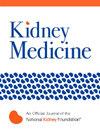矿皮质激素受体拮抗剂对慢性肾病患者肾脏和心血管预后的疗效:综述
IF 3.4
Q1 UROLOGY & NEPHROLOGY
引用次数: 0
摘要
基本原理及目的全面总结矿皮质激素受体拮抗剂(MRAs)改善慢性肾病(CKD)患者肾脏和心血管(CV)预后的疗效。研究设计从Medline和Scopus数据库中选取相关的研究,从研究开始到2023年8月。设置,研究人群:非透析或透析CKD患者。研究的选择标准本研究纳入了随机对照试验(rct)的系统评价和荟萃分析(SR-MAs),这些试验研究了MRAs对非透析或透析CKD患者肾脏和心血管结局的疗效。资料提取提取研究、受试者特征及治疗效果。分析方法根据患者类型和mra进行疗效定性总结。结果共纳入40例SR-MAs。与安慰剂/常规治疗相比,仅在接受透析治疗的患者中,甾体MRAs (sMRAs)与安慰剂相比,在降低全因(合并RRs为0.38[0.22-0.65]至0.87[0.77-0.98])和CV死亡率(合并RRs为0.34[0.15-0.75]至0.46[0.28-0.76])方面具有显著的益处。非甾体类MRAs (nsMRAs)可显著降低非透析CKD(合并RRs为0.86[0.79-0.94]至0.92[0.85-0.99])和糖尿病肾病(DKD)患者(合并RRs为0.86[0.78-0.95]至0.88[0.81-0.96])的复合CV事件。此外,与安慰剂相比,nsMRAs在降低非透析CKD或DKD患者的复合肾脏结局方面显示出显著的益处。然而,在DKD患者中,这种疗效低于钠-葡萄糖共转运蛋白-2抑制剂(SGLT2i)。此外,sMRAs和nsMRAs均显著增加非透析性CKD和DKD患者高钾血症的风险。nsMRAs和SGLT2i之间的比较是基于网络元分析。因此,需要额外的头对头随机对照试验来证实SGLT2i优于nsra。结论:在接受透析治疗的患者中,smras可降低全因死亡率和心血管死亡率以及复合心血管事件。nsMRAs可改善非透析CKD和DKD患者的肾脏预后,但会增加高钾血症的风险。慢性肾脏疾病(CKD)会增加患严重肾脏问题和心脏病的风险。肾衰和心脏病风险的一个关键因素是矿化皮质激素受体(MR)的过度激活。被称为MR拮抗剂(MRAs)的药物可以降低心脏病的风险。我们对所有关于甾体MRAs (sMRAs)和非甾体MR拮抗剂(nsMRAs)的现有研究进行了全面的回顾,以了解它们如何有助于减少不同类型CKD的肾脏和心脏问题。我们的综述发现,在接受透析治疗的患者中,sMRAs显著降低了因各种原因死亡和心脏问题的风险,而在不需要透析的患者中,nsMRAs则降低了心脏和肾脏问题的风险。然而,这两种类型的mra确实增加了需要非透析的患者高钾的风险。本文章由计算机程序翻译,如有差异,请以英文原文为准。
Efficacy of Mineralocorticoid Receptor Antagonists on Kidney and Cardiovascular Outcomes in Patients With Chronic Kidney Disease: An Umbrella Review
Rationale & Objective
To comprehensively summarize the efficacy of mineralocorticoid receptor antagonists (MRAs) to improve kidney and cardiovascular (CV) outcomes in patients with chronic kidney disease (CKD).
Study Design
Relevant studies were identified from Medline and Scopus databases from their inception up to August 2023.
Setting & Study Populations
Patients with nondialysis or dialysis CKD.
Selection Criteria for Studies
Systematic reviews and meta-analyses (SR-MAs) of randomized controlled trials (RCTs) that investigated the efficacy of MRAs on kidney and CV outcomes in patients with nondialysis or dialysis CKD were included in this study.
Data Extraction
Characteristics of studies and participants, and treatment effects were extracted.
Analytic Approach
Efficacy of MRAs was qualitatively summarized according to types of patients and MRAs.
Results
Forty SR-MAs were included. When compared with placebo/usual care, steroidal MRAs (sMRAs) provided significant benefit in decreasing all-cause (pooled RRs of 0.38 [0.22-0.65] to 0.87 [0.77-0.98]) and CV mortality (pooled RRs of 0.34 [0.15-0.75] to 0.46 [0.28-0.76]) only in patients treated with dialysis, when compared with placebo. Nonsteroidal MRAs (nsMRAs) significantly lowered composite CV events in both nondialysis CKD (pooled RRs of 0.86 [0.79-0.94] to 0.92 [0.85-0.99]) and patients with diabetic kidney disease (DKD) (pooled RRs of 0.86 [0.78-0.95] to 0.88 [0.81-0.96]). In addition, nsMRAs showed significant benefit in reducing composite kidney outcomes in patients with either nondialysis CKD or DKD when compared with placebo. However, this efficacy was lower than sodium-glucose cotransporter-2 inhibitors (SGLT2i) in patients with DKD. Moreover, both sMRAs and nsMRAs significantly increased the risk of hyperkalemia in patients with nondialysis CKD and DKD.
Limitations
The comparison between nsMRAs and SGLT2i is based on network meta-analyses. Consequently, additional head-to-head RCTs are necessary to confirm the advantages of SGLT2i over nsMRAs.
Conclusions
sMRAs offer benefits in reducing all-cause and cardiovascular mortality and composite CV events in patients treated with dialysis. nsMRAs improve kidney outcomes in patients with nondialysis CKD and DKD but increase hyperkalemia risk.
Plain Language Summary
Chronic kidney disease (CKD) can increase the risk of severe kidney problems and heart disease. A key factor in kidney decline and heart disease risk is the overactivation of mineralocorticoid receptors (MR). Medications called MR antagonists (MRAs) may lower heart disease risk. We performed a thorough review of all existing studies on both steroidal MRAs (sMRAs) and nonsteroidal MR antagonists (nsMRAs) to see how they might help reduce kidney and heart problems in different types of CKD. Our review found that sMRAs significantly lower the risk of death from all causes and heart issues in patients treated with dialysis, whereas nsMRAs reduce the chances of heart and kidney problems in patients not requiring dialysis. Both types of MRAs, however, do increase the risk of high potassium in patients requiring nondialysis.
求助全文
通过发布文献求助,成功后即可免费获取论文全文。
去求助

 求助内容:
求助内容: 应助结果提醒方式:
应助结果提醒方式:


